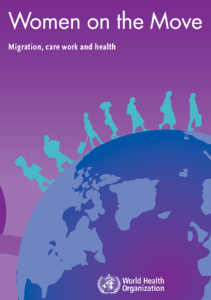World Health Organization

WHO has produced a new report on this population group, collating evidence across sectors.
In so many homes and places around the world, women of all ages, ethnicities, cultures and backgrounds are providing essential care to others, within and outside their own families, to sustain health, well-being and comfort. While men also contribute, available data show that the overwhelming proportion of care workers worldwide is women, and increasingly they are migrant women.
As women’s economic empowerment builds, lives are being transformed, including decisions made to travel from their own homes, families and communities to earn a living.
In the destination countries and territories, these migrant women are making a positive contribution to the health and well-being of others as they work in the care sector, often informally. They fill unmet needs for long-term care in our ageing societies and buttress health and
social care systems in many countries as a kind of invisible subsidy.
However, their own health is at stake. Are they able to access the services they need? If not, why not, and what can be done about it? What happens to the health and care situation for the families they leave behind? Although there are still more questions than answers and data gaps remains substantial, it is right and timely to ask such questions, and develop and implement workable solutions as a global community.
This report shed light on a particular population group that both provides care as well as needs it to
maintain their own health and well-being. It looks at the lives of these migrant women care workers as well as the situation for their households left behind. It takes a transnational perspective appropriate to our interconnected world.
READ THE FULL REPORT

